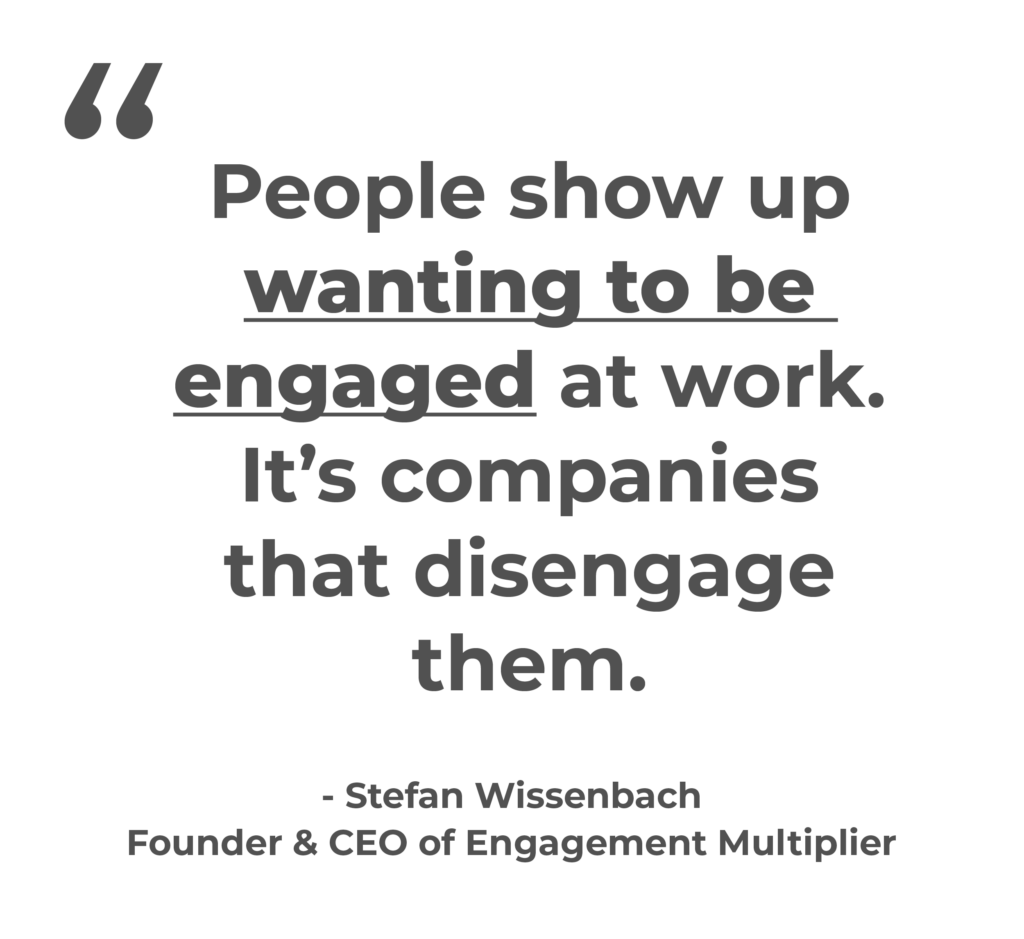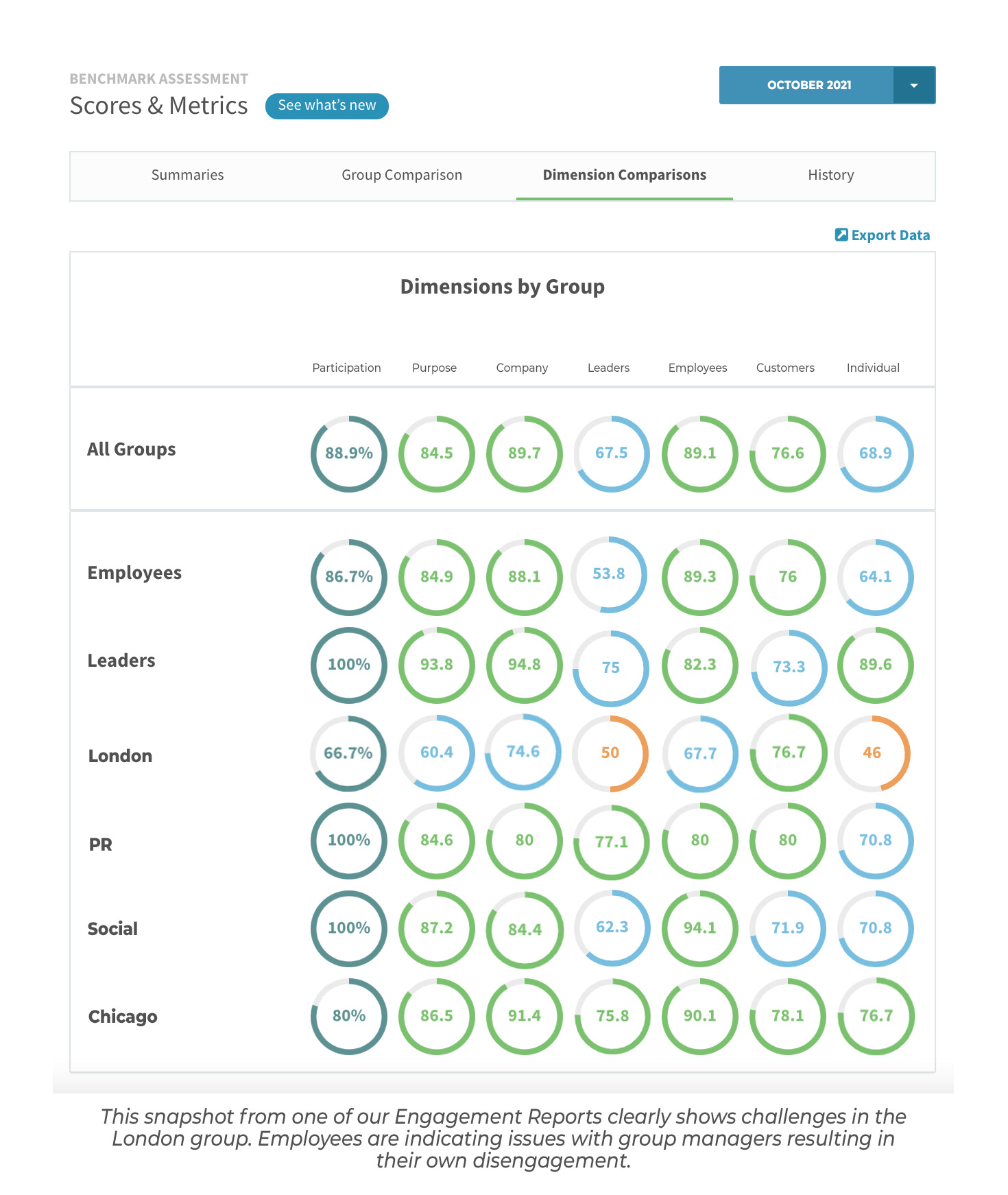Re-engaging disengaged employees is another important tactic for leaders who are seeking to improve retention, morale, and performance. Understanding how to re-engage disengaged employees is crucial, because without re-engagement, other retention tactics – such as retention bonuses, pay raises, and flexible work arrangements – are likely to have minimal impact.
Before we break down how to re-engage disengaged employees, let’s first look at the current environment, to understand some of the root causes of the current increase in employee disengagement.
- Employee disengagement is rising. The stats won’t surprise anyone who has been reading headlines about ‘The Great Resignation’ – according to the Society of Human Resources Executives (SHRM), employee engagement dropped in 2021, and 16% of people surveyed reported being actively disengaged.
- The reasons for disengagement have changed, and are likely precipitated by both the increase in people working from home as well as uncertainty about hybrid work and return to office plans. Employees experienced increases in lack of access to resources needed to do their jobs, lack of clarity around expectations, and feeling they couldn’t do their best work to a greater degree in 2021 than in previous years.
- Non-executive managers are displaying much higher than average levels of disengagement, which very likely has a trickle-down effect on their employees, given the impact managers have upon employee engagement. Upon reflection, this should be of little surprise: the pandemic threw curveball after curveball at managers, and many simply didn’t have much training or experience to guide them.
Re-engaging your team: start with the basics
Stefan Wissenbach, our founder and CEO, has a good saying: “People show up wanting to be engaged at work. It’s companies that disengage them.” And he’s right. Disengagement happens when people are frustrated by lack of training, unfair treatment, and uncaring or inexperienced managers.
To re-engage employees who seem to have lost their energy and enthusiasm, leaders should start with the basics and ensure the core elements of employee engagement are firmly established.
The drivers of employee engagement are measurable and are hallmarks of good management, and include:
- Providing employees a clear understanding of their roles and responsibilities
- Ensuring staff have the tools, training, and resources needed to do their job
- Recognizing people for their contributions and successes
- Prioritizing opportunities for training and professional development
- Creating an environment in which employees have an authentic voice
- Leadership that cares about the well-being of employees and treats people fairly and with respect
- Promoting a sense of purpose, and contributing to the good of the community.
A pizza party or virtual cocktail hour won’t solve the underlying problems that are annoying, exhausting, and frustrating employees to the point their enthusiasm is sapped.
However, getting organised, and ensuring employees’ roles and responsibilities are clearly defined and communicated, measured transparently, and resourced appropriately are things that are easy to do (and probably should have been happening all along,) and don’t require additional budget.
Help disengaged managers
As we mentioned earlier, the pandemic and resulting chaos, uncertainty, and human impact together presented managers with a crash course in advanced organisational psychology and management, posing a problem for the many who only had the most cursory prerequisites under their belts.
An engagement survey can quickly help diagnose where within an organisation managers may be struggling – the tell-tale signs can be quickly spotted in the “leaders” section of the Engagement Multiplier comparison report, which captures employees’ perceptions of their direct leaders.
Identifying struggling managers is the first step. Identifying the specific areas in which they’re struggling, and providing coaching to help them improve, are the next important steps.
To come to the aid of your managers, and lay the groundwork to re-engage them, we’ve created a free set of tools:
- The Seven C’s: Qualities Leaders Need for Post-Covid Success, an ebook and coaching tool that provides guidance and tools to improve leaders’ self-awareness and soft skills,
- Leadership Self-Reflection Scorecard: A simple self-assessment tool that can be used by individuals, coaches, or managers developing their team to identify opportunities for improvement,
- The Leadership Perception Gap survey: A short on-demand survey designed to indicate where leaders are thriving (or struggling) within the organisation, providing executives with a clear understanding of where some focused attention is needed.
Helping a struggling manager who is willing to develop needed skills is an important re-engagement opportunity. It provides an important development opportunity and signals to them your confidence in their abilities. You can help keep them accountable for their development by making them a partner in re-engaging their team, focusing on the core drivers of engagement we outlined above. If you do quarterly engagement assessments (the cadence we recommend) you also have the perfect way to measure the manager’s progress with their team.
A focused approach to re-engaging employees
To re-engage disengaged employees, the crucial first step is identifying what’s causing them to disengage. Especially if your organisation is larger, chances are good you’ll identify a variety of factors. In addition to struggling managers, other common causes of disengagement include increased workloads and a lack of autonomy or agency over various aspects of work. Understanding what forces are afoot in your organisation before taking action will do two things: it will save you a lot of time, and you’ll be likely to uncover real solutions that stick.
Our recommendation is to start by surveying the whole team without delay. This is an important point: surveying the organisation when it’s being challenged will provide executives with a much sharper view of how the organisation and its leaders are performing and is also likely to net both a larger response rate and more insightful feedback. The raft of intelligence an employee survey that’s fielded during a challenging time can be invaluable to aiding recovery and regaining the path to success.



